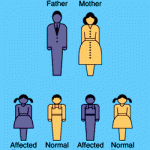The American Heritage Dictionary explains that a disease is
“A pathological condition of a part, an organ, or a system of an organism resulting from various causes, such as infection, genetic defect, or environmental stress, and characterized by an identifiable group of signs or symptoms.”

Neurodegenerative diseases like Parkinson’s and Alzheimer’s may soon be curable with the use of stem cells. Breakthroughs in cell biology and telomere research are leading to treatments for cancer. Vaccines are being researched for AIDS and tuberculosis. Genes associated with type 1 diabetes and certain types of cancer have been discovered allowing for new therapies to be developed.
Artificial devices attached directly to the nervous system may restore sight to the blind. Drugs are being developed to treat a myriad of other diseases and ailments.
Disease is theoretically surmountable via technology. Human understanding of genetics is leading to cures and treatments of a myriad of previously incurable diseases.
The mechanisms by which other diseases do their damage are becoming better understood. Sophisticated methods of detecting diseases early are being developed. Preventative medicine is becoming better understood.
Most “popular” diseases
Ischemic heart disease
Thrombi are clots that form in the blood vessels of and leading to the heart whereas emboli are air bubbles, blood clots or foreign bodies travelling through the body. Both can lead to a condition known as ischemia, when the blood flow to an organ is cut off, thus preventing the critical waste removal and oxygen and glucose supply integral to the functioning of all cells. It usually cause pain in the shoulders or elsewhere (angina) and lead to an heart attack when thrombi or emboli lodge in heart vessels. A heart attack is “Acute myocardial infarction typically resulting from an occlusion or obstruction of a coronary artery and characterized by sudden, severe pain in the chest that often radiates to the shoulder, arm, or jaw.” American Heritage Dictionary
Cerebro-vascular disease
Strokes can be caused by both emboli lodging in vessels leading to the brain and the rupturing of blood vessels in the brain caused by hypertension. The brain is a very sensitive organ that requires a constant blood flow or else irreversible damage will result.
Cancer
Cancer is the uncontrolled growth of cells resulting in tumors that then spread and harm others parts of the body. A variety of treatments have been found and are being sought for the various types of cancer, but still it is often fatal.
Cancer of lung, trachea, bronchus
Lung cancer is now the leading cause of death from cancer, having more than tripled in death rate from 1950 to 1985. It is most often the result of cigarette smoking. Cigarettes are loaded with carcinogens (chemicals that causes cancer). The cancerous tissue grows rapidly so that it is essentially destroyed for the passage of air, and the area around it fails to take in air. The cilia that remove particles that arrive in the lungs along with air are also hurt by elements in cigarette smoke and are not even present in cancerous cells.
Cancer of stomach
Although deaths from stomach cancer have decreased, it is still a serious issue. Symptoms are very vague, including indigestion, bleeding, nausea and loss of appetite. Risk factors include being over 55, male, Black, outside the United States and having stomach bacteria, pernicious anemia, acholrydia and gastric atrophy, exposure to certain dust and fumes.
Cancer of female breast
Breast cancer is the second leading cause of cancer death (behind lung cancer) in women, developing in one in nine American women. It is detected by mammography (x-rays) or physical exam. Although the cause is not known, it occurs predominantly in older women. Excessive or careless sun exposure is also often associated to breast cancer.
Bronchitis, emphysema, asthma
Emphysema, the abnormal increase in air space size in the lungs that can be the result of preventing alveoli constriction that makes breathing harder, is also often a result of smoking, though it can also be the result of air pollution, and it is the fourth largest cause of death in the United States. Bronchitis, the chronic inflammation of the bronchial tube’s mucous membrane, and asthma, a constriction of passages causing labored breathing, are a related respiratory illnesses.
Chronic liver disease and cirrhosis
Cirrhosis is caused by alcohol abuse, poor nutrition or infections such as hepatitis. It occurs when functional liver cells are replaced by fibrous, nonfunctional ones.







